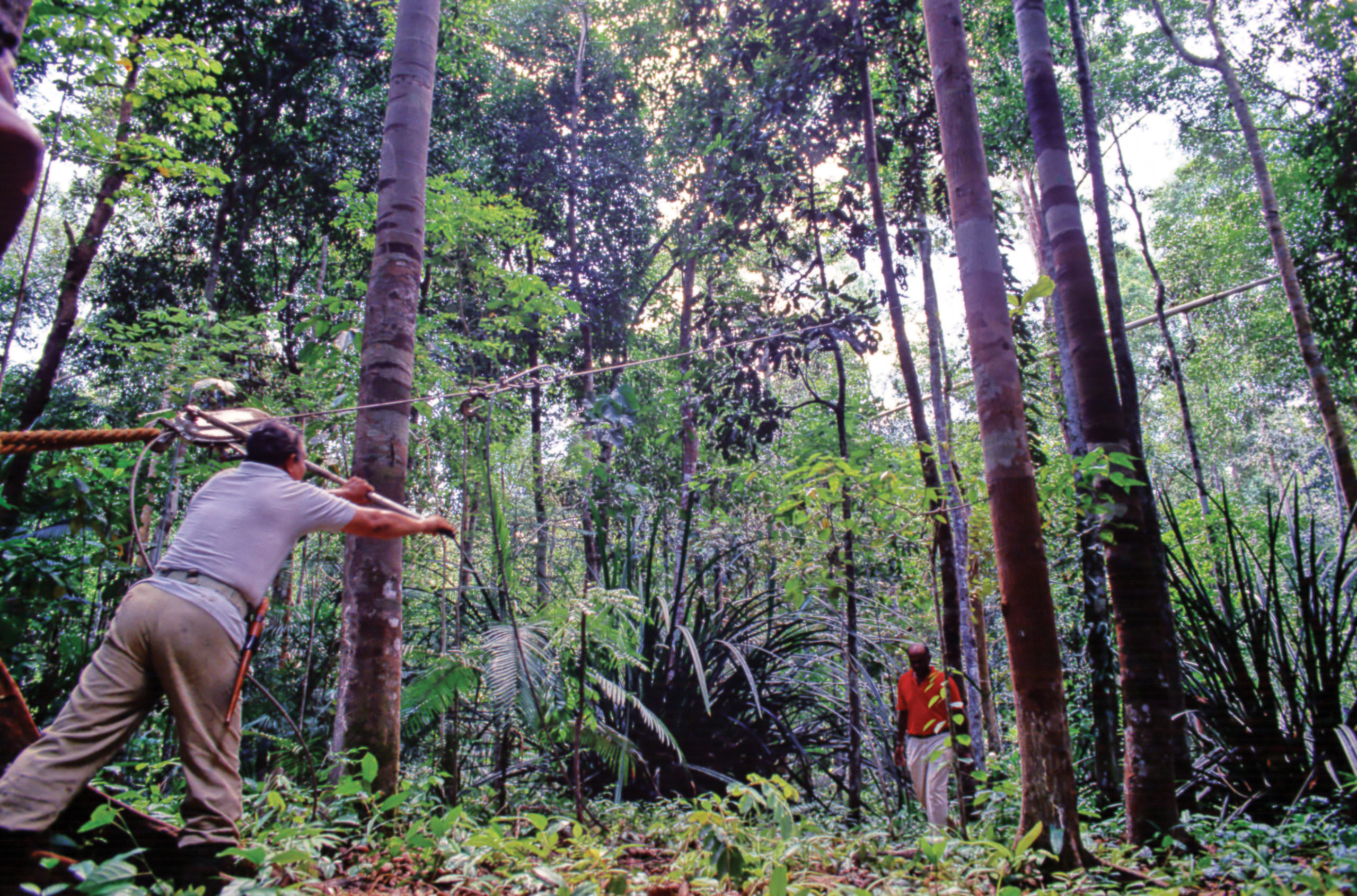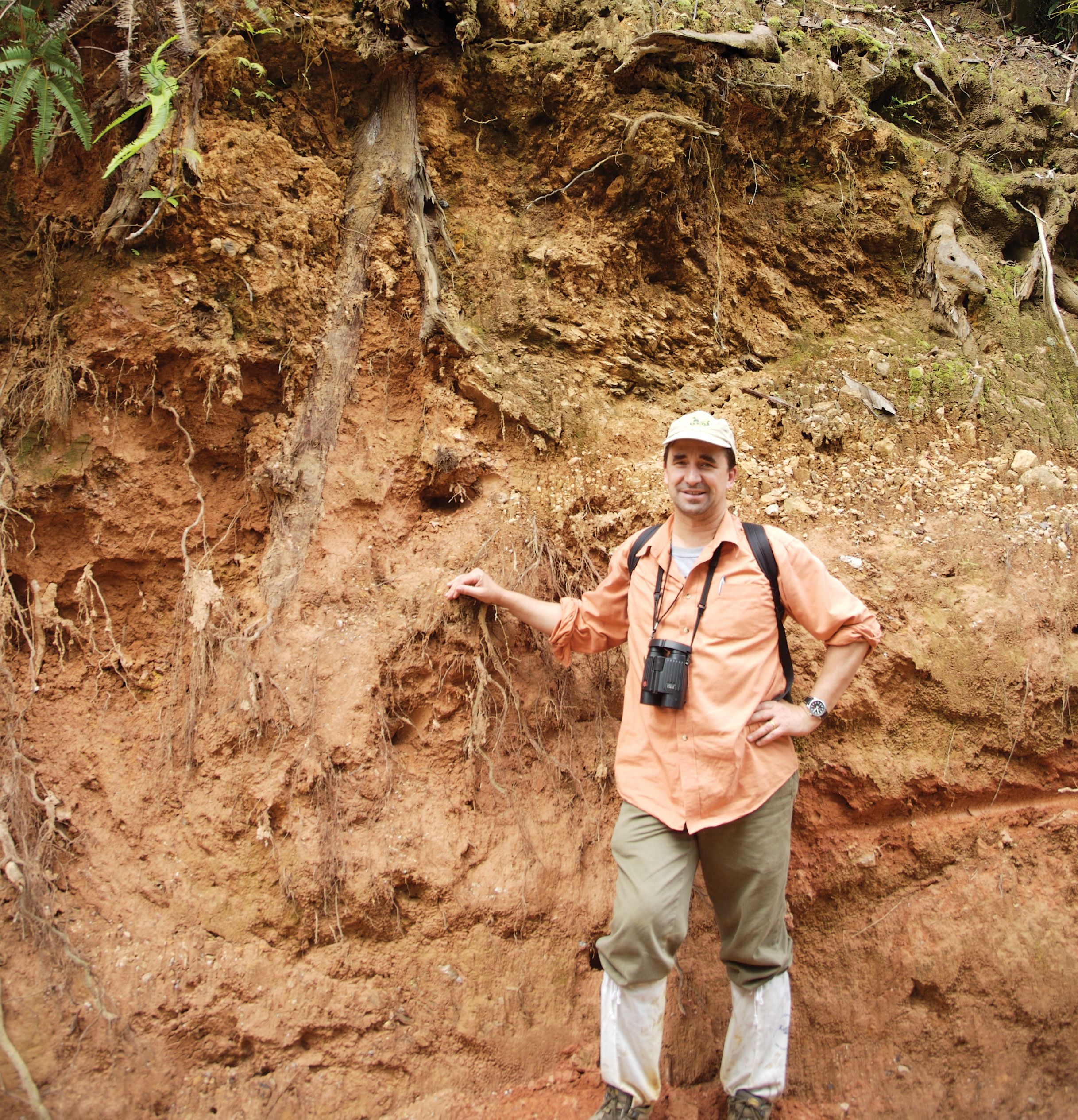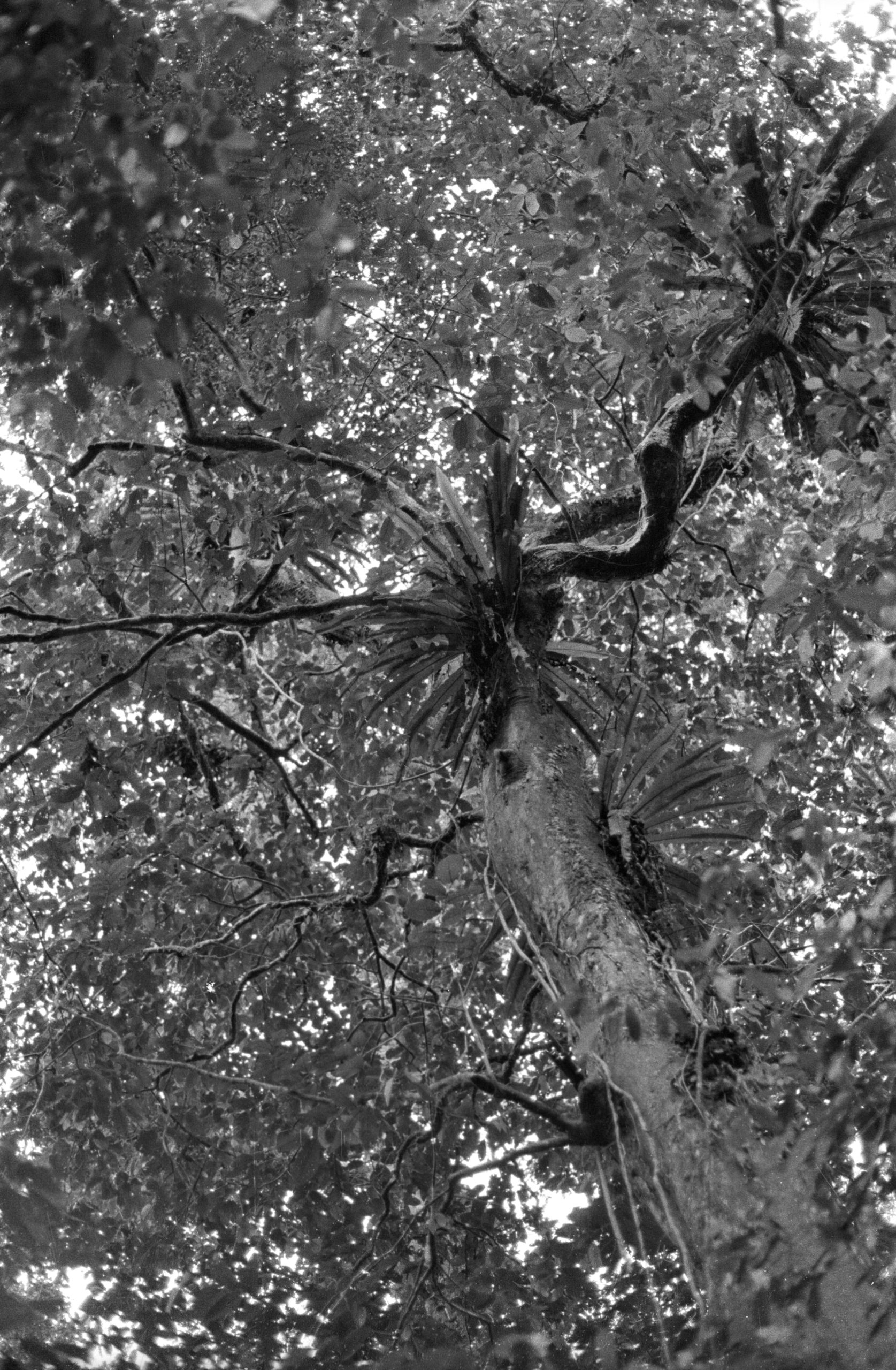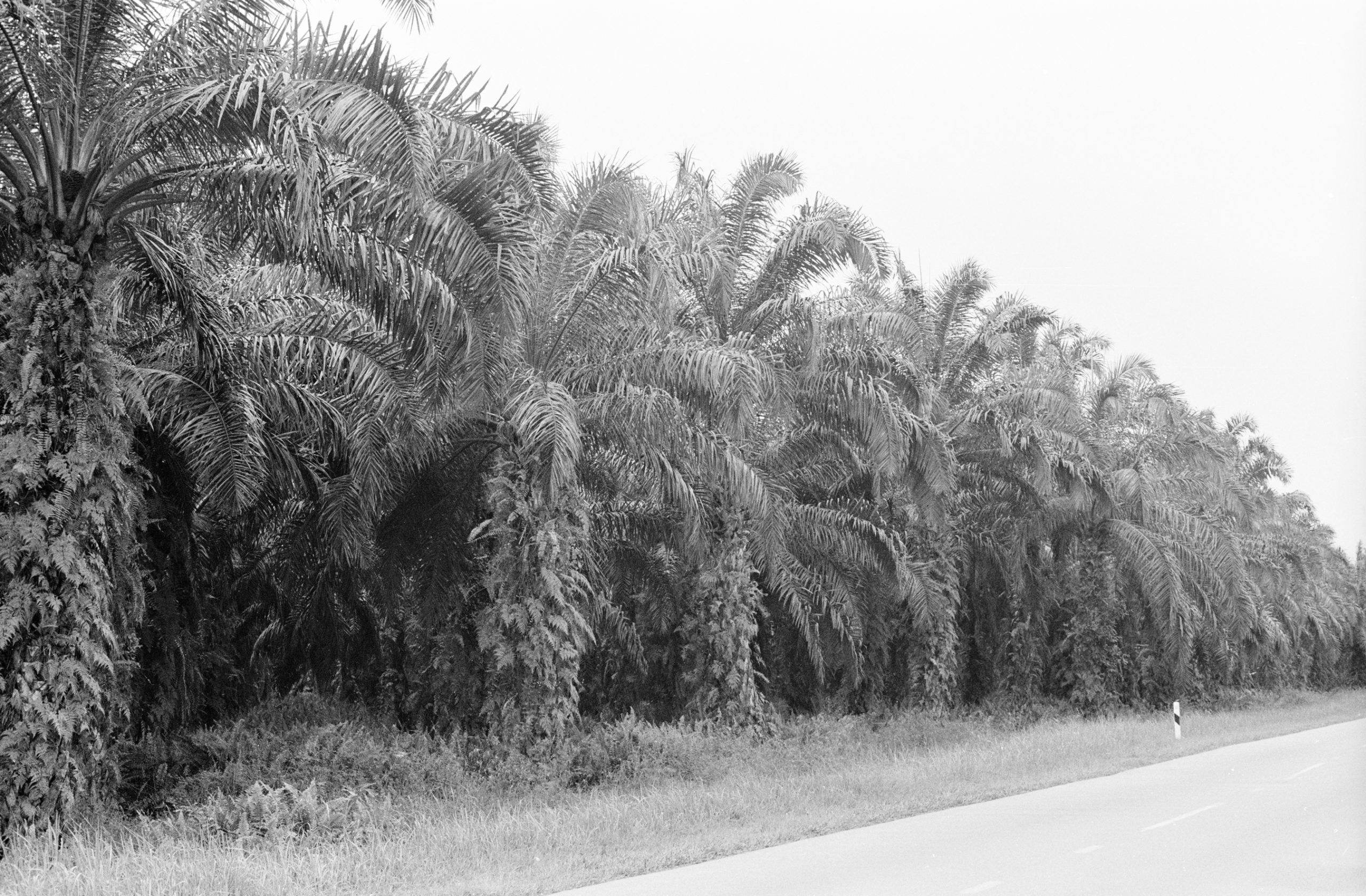Aberdeen, Scotland, as it was when I arrived as a professor, in 1966, at the cusp of the North Sea oil bonanza, was a very different coastal town from those in Brunei and Sarawak, where I had been based for eight of the previous ten years, while conducting fieldwork in the rainforests of Borneo. At 57° north latitude, the summer skies in Aberdeen never completely darken and native tree species are few, but the University of Aberdeen had a long tradition of research and instruction in tropical agriculture, including tea and rubber. As a new professor, I found colleagues with common interests, who shared my enthusiasms and encouraged me to continue in my research. A central puzzle had grown in my mind: How can so many species of giant sessile organisms—rainforest trees—apparently coexist in stable mixture and how did these communities originate?
Elmer Merrill, celebrated botanist of East Asian floras and director of the Arnold Arboretum from 1937 to 1946, reasoned that the extraordinary species diversity of tropical and warm temperate forests in East Asia suggested an origin there for all flowering plants. Paleontological research and the growing science of molecular phylogeny would ultimately indicate the reverse—suggesting that the Aisian tropics were primarily devoid of broadleaf evergreen rainforests until the current tree families invaded in more recent evolutionary history—yet the warm, wet equatorial climate of the tropical Far East appears, nevertheless, to be optimal for tree growth and survival. Around 4,500 plant species are known to occur in northern Borneo. Understanding how rainforest tree species sustain a stable mix within their communities and why these communities vary in species diversity was more than theoretical interest: If species are distributed at random within their soil-defined communities, how could consistent and predictable protocols for silvicultural management following timber harvesting be devised?
~
At the time, research in temperate ecosystems was revealing that populations of tree species were remarkably genetically variable. This was the opposite of the widespread assumption that, for rainforest trees in species-diverse communities, self-pollination would prevail, resulting in low genetic variability within populations. As Charles Darwin foresaw, natural selection depends on the existence of diversity, which we now know to be genetic and heritable. Genetic uniformity within populations would imply lack of selection and suggest that species sharing the same habitat are ecologically complementary, surviving together through the random consequences of their seed dispersal. We decided to adopt a broad approach to explore these issues, combining cross-pollination experiments with comprehensive observation of the reproductive biology of selected species, tracking them from bud formation to seed dispersal. We would bag the flowers after carefully brushing pollen onto the stigmas and then examine the genetic consequences of these crosses, comparing the genetic variability of the seedlings to the variability sampled among trees in the broader population.

This research came with formidable challenges: the first was to find a safe way to ascend a 150-foot (45-meter) tree to its outer twigs in order to manipulate cross-pollination using a squirrel-hair artists brush. We were fortunate from the start. The North Sea oil was beginning to flow. I found an enterprising oilfield engineer who would work with me to devise a means of reaching the flowers through tree prosthesis: Three telescoping aluminum alloy booms, each 15 feet (4.6 meters) long, which were light enough to be carried into the forest to a tree about to flower. Combined with a cable, ropes, a simple manual dockside winch, and a boatswain’s chair, the booms allowed a researcher to be lifted to the place of operation. But who among us academics, approaching middle age, would volunteer? The solution was obvious: find some students! So it was that I managed to write a persuasive grant proposal to an independent foundation created by the Unilever Corporation, from which I succeeded in gaining the necessary support. Six graduate scholarships were awarded for Malaysian students who had the necessary combination of fieldwork interest and some experience, curiosity, scientific acumen, and derring-do. Three women and three men were selected.
Each student variously focused on the reproductive biology of both an emergent and a subcanopy tree species. Fieldwork was carried out at the Pasoh Forest Reserve, in central Peninsular Malaysia, about one hundred miles southeast of the capital city, Kuala Lumpur. At that time, the pollinators of dipterocarps—trees in the family Dipterocarpaceae, which dominate the overstory of these rainforests—were unknown. But in the second year, student Chan Hung Tuck collected inflorescences from a tree, sealed them in a plastic bag, and took them back to his lab at the university. To his amazement, when he opened the bag the following morning, he found several tiny insects and holes in the buds from which they had apparently escaped: thrips. Another student, Simmathiri Appanah, immediately got to work, dangling sticky plastic bottles in the canopy to trap insects. Together, their work confirmed that thrip eggs were laid in the flower buds and that thrip populations increased day by day as the dipterocarps developed buds en masse. When the open corollas fell to the ground beneath, a haze of tiny organisms was released, the insects batting their oar-like wings in the humid air. Petals are one of the very few plant organs not chemically defended in the rainforests, so they are like vegetarian McDonald’s hamburgers sustaining rainforest insect diversity.
The genetic work yielded unexpected results as well. The Pasoh population of the dipterocarp Shorea leprosula, by then the chosen emergent for all our research, proved to have a genetic structure remarkably similar to the average temperate broadleaf canopy tree, with variability relatively low among neighboring trees but increasing to a population average at a radius of about 330 feet (100 meters). This is consistent with the maximum usual distance of dispersal of the winged dipterocarp fruit and the possible distance that thrips might be wafted by daily air turbulence within the sunny forest canopy. Later studies by others have confirmed that this phenomenon is close to the general rule, although some emergent dipterocarps and trees in other families attract pollinators that forage over long distances. Examples we examined included tree species visited by the giant Asian honey bee (Apis dorsata) and others visited by a cave-roosting, nectar-feeding bat (Eonycteris spelaea). Many of these same tree species bear large comestible fruit, the seeds of which are dispersed by mammals and large birds. It was becoming clear, however, that a preponderance of minute, small-winged pollinators, wafted aloft between distant conspecific individuals in the forest cornucopia, was maintaining genetic diversity across widespread habitats.

Critically important, Robert MacArthur and my future Harvard colleague Edward O. Wilson had shown, in their 1967 book, The Theory of Island Biogeography, that animals on islands accumulate species at rates of immigration and extinction that vary with the area of the island: an increase of area by 90 percent is required to double the size of a fauna. Dipterocarps, however, did not follow these predictions. Whereas the large island of Sumatra includes just over 100 dipterocarp species, there are 158 species in Peninsular Malaysia, only one quarter of the area, while Borneo, one and one half the area of Sumatra, contains 270 species. The overall tree floras are consistent with these figures. As a consequence, the relationship between the number of motile organisms—animal species—and the land masses they occupy, predicted by MacArthur and Wilson, are rarely achieved by plants, especially trees, on account of the diversity of soils within which species are confined by interspecific competition.
~
I joined the staff of the Arnold Arboretum in 1978, and my time as director was, for a while, fully occupied with pressing issues at Jamaica Plain. But in 1982, I attended a meeting on tropical forest ecology with my former Aberdeen student Ian Baillie, a tropical forest soil scientist. We presented a paper showing how soil nutrients governed forest community composition at topographic and geologic spatial scales in lowland Borneo. I had, by that time, become convinced that tree species in hyperdiverse rainforests were niche specific, and I published a pioneer paper to that effect.
Also presenting at the conference was someone unfamiliar to me from the University of Iowa, Steven Hubbell. His paper gave me a shock! His approach and conclusion were dramatically different from my own. He had established one large tree-demography plot that covered 124 acres (50 hectares) on a relatively uniform and gentle slope on Barro Colorado Island, a research island in the Panama Canal, administered by the Smithsonian Tropical Research Institute. Steve had censused, tagged, mapped, and identified all trees larger than 0.4 inches (1 centimeter) in diameter, numbering over three hundred thousand trees—a staggering figure. From this, he had convincingly shown that the spatial distributions of the species were consistent solely with the constraints of limited seed dispersal from parent trees. He concluded that the species were ecologically complementary with one another and were therefore consistent with the geographical expectations of the theory of island biogeography after all.
Following his session, I was in a state of shock. How then, if at all, could the hundreds of tree species sharing a common habitat distribute themselves independent of any variation in their physical habitat? I introduced myself and suggested we retire to a neighboring pub to hammer out our differences over a pint or two. We realized that the disagreement likely arose from our different sampling methods: my small plots were distributed across variable landscapes on a regional scale while his single large plot represented a uniform habitat. My plots were too small to detect local patterns, nor had I mapped my trees, while his plot may have been too small to detect habitat-related floristic change in relation to topography, nor had he sampled soils. We agreed that the way forward was to replicate his large plot on the other side of the world. I gained the support of my friend Salleh Mohd Nor, the director of the Malaysian Forest Research Institute, to establish a 124-acre (50 hectare) plot on the gentle topography of Pasoh Forest Reserve. Then, Steve and I successfully persuaded the National Science Foundation to fund it. We would use identical census protocols at both sites and recensus each every five years. The aim was to resolve the central, as yet not fully resolved question: To what extent are rainforest tree species niche specific and to what extent are they spatially restricted by their limited seed dispersal?
I was soon in luck again: the United States ambassador in Thailand, John Gunther Dean, was a resource economist, and he recommended that the State Department should host a regional conference in East Asia on research priorities for the sustainable development of natural resources. The State Department was looking for someone to orchestrate it. I jumped at the opportunity. With support from the National Science Foundation and Agency of International Development, I then toured the region seeking advice from friends and colleagues. It was not difficult to gain consensus for the concept of a regional network of representative forest community samples. The sites would follow Steve’s protocol, varying in area such that each captured at least one hundred individuals of half the species represented.

Thus, the Center for Tropical Forest Science (CTFS) was born—an informal collaboration of national researchers and their institutions. This became part of the Smithsonian Tropical Research Institute but was managed from the Arnold Arboretum until my retirement in 2000. CTFS has since expanded to become a component of the Smithsonian’s new Forest Global Earth Observatory (ForestGEO). This expansion aims to build international capacity in forest science, monitoring the effects of climate change on natural terrestrial ecosystems. The program is now directed by Stuart Davies, who, as one of my Harvard graduate students, completed elegant field observations and experiments on habitat differentiation within a species-diverse genus of pioneer trees, Macaranga, a member of the spurge family (Euphorbiaceae). Crucially, Stuart had already gained the friendship of our regional partners. Although still best represented in East Asia, there are now sixty-seven forest research sites worldwide, including one at Harvard Forest, and more than six million individual trees monitored. More than four hundred published peer-reviewed papers underwrite the massive acceleration in our knowledge of forests.
~
The CTFS focus on understanding tropical rainforest species diversity continues, but the work has revealed unexpected patterns: Plot species diversity, instead of increasing with habitat favorability, unexpectedly peaks at quite low levels of soil nutrients. This, interestingly, supports a theory advanced by ecologist David Tilman, now at the University of Minnesota, in his Princeton doctoral dissertation. He predicted that the low species diversity of plant communities in habitats that are severely limited by low fertility, drought susceptibility, or shadiness is enhanced once these limiting factors start to relax. As soon as these factors relax past a certain threshold, however, one or a few of the species that grow fastest overtop the rest, suppressing subsequent diversity by competitive shading or by hindering establishment. The pattern shown by our plots confirmed the prediction remarkably, independent of the distance between plots.
But that is not the whole story. We are still left with insufficient explanation as to how so many tree species can co-occur in a single community. Some years later, our postdoctoral researcher Koichi Kamiya used molecular genetic analysis of seedlings beneath a grove of four distinct but related Shorea species and found that although many were hybrids, very few of the reproductively mature trees were of hybrid origin. This provided clinching evidence that selective mortality results in survival only of those individuals that retain the parental genome and reoccupy the parental, as yet undefined, niche.
Competitive selection also leads to differentiation of flowering times, stature, and response to light among sister species, but these explanations are surely insufficient explanations for the co-occurrence of this incredible biodiversity. Joseph Connell, at the University of California, and Dan Janzen, at the University of Pennsylvania, independently proposed that high diversity could be maintained if each species were to attract a single seed predator, such that seed mortality (causing fewer juveniles near parent trunks) would lead to space available for the establishment of others. But no vertebrate seed predators are so specialized. Czech entomologist Vojtech Novotny has convincingly shown, through studies in New Guinea, that herbivorous insects attack at a generic rather than species level. Instead, researchers, notably Yale professor Liza Comita and her students at the Barro Colorado Island plot, have discovered that the prevalent mortality of established seedlings in hyperdiverse rainforest tree communities is mediated by host-specific pathogenic microorganisms, especially fungi and viruses. If mature populations of particular tree species are less dense, the seedlings are less chemically defended. These less-common species include trees whose seeds and pollen are the most widely dispersed, including species like the wild progenitors of cultivated mangoes (Mangifera), rambutans (Nephelium), and durians (Durio), which produce few fleshy fruits that are sought by mammals and large birds.
Now, with hundreds of findings resulting from the CTFS coordination and research continuing to expand, we can conclude that niche specificity does indeed govern floristic structure within and between tree species in hyperdiverse plant communities such as rainforests, except at very local levels where the pull of limited seed dispersal is influential. As such, the pub dispute with Steven Hubbell, back in 1982, can be resolved: ecological niches occupied by particular species become increasingly specialized over time thanks to competitive interactions, so MacArthur and Wilson’s theory of island biogeography can generally be applied to rainforest tree biodiversity at the local scale (a habitat island), but the theory rarely applies more broadly, because climate or geological changes ensue before an equilibrium can be reached in the number of large, long-lived plant species that might eventually occupy a nation-sized island.
~
When I first began my research career in Borneo, in 1957, the limitless lofty forests, the unforgettable aromas, and the bird-and-cicada orchestra echoing through the cathedral-like subcanopy were nothing short of glorious. Things are now so very different. The two British colonies, Sabah and Sarawak, united as states within independent Malaysia at an ominous time. Peninsular Malaysia had gained independence in 1957, at the moment when the African oil palm (Elaeis guineensis) was beginning to be a serious commercial competitor to the Brazilian rubber tree (Hevea brasiliensis), causing increased demand for new agricultural land. Agronomists in Peninsular Malaysia recommended that all soils that supported mixed dipterocarp forest were suitable for oil palm cultivation. Legal constraints on timber exports were relaxed. The international trade peaked, with oversupply depressing prices. Sustainable forest management languished. Now, Pasoh contains the only inland mixed dipterocarp forest remaining unlogged in Peninsular Malaysia outside the parks.

In Borneo, the same fate awaited mixed dipterocarp forests ten years later. With dominance of demand from Japan, and later China, a local wood-based industry, which had benefitted from government investment in research such as mine, went into decline. Brunei, prospering from its oil, has alone retained aboriginal forest over two thirds of its modest land area, timber harvesting being allowed only for the home market. My initial campsite in Brunei, back in 1957, at Kuala Belalong, now hosts a university forest research and training camp, while our plots in the Andulau hills, closer to the coast, are now encompassed within a research preserve and an adjacent forest service research station.
In Sabah, thanks in part to political gains among the inland communities, a successful expansion of an ecotourism industry, and an outstanding and farsighted director of forests, Datuk Sam Mannan, large tracts have been conserved and riparian fringes protected. But Sabah was far from immune to events that happened in Peninsular Malaysia and those that followed in Sarawak, where politicians saw timber licenses as a ready bribe to induce candidates to change sides. In Sarawak, politicians and their families became the new rentier elite, with the power to delegate timber licenses, awarded over periods that often corresponded with elections rather than felling cycles of fifty years or longer. Licenses were, in turn, delegated to companies of industrious and enterprising overseas Chinese, who have used their profits to expand their operations as far as New Guinea and South America. Young Dayaks hazarded their lives as saw operators at one hundred dollars a day, too often with tragic consequences. Now, other than in the parks, little of the original rainforest remains in Sarawak.


On climbing the basalt peak of Bukit Mersing, in central Sarawak, I recall looking down in wonder on the lavender cascades of the rare strangler Wightia borneensis in flower. But, years later, a silviculturist apologetically confessed to me that this magnificent park, which I had proposed given its rich diversity of rare and endemic species, had “inadvertently” been licensed for logging. Our permanent plots there were trashed, and those in coastal Nyabau forest were cleared for an oilfield service depot. Of all our thirteen plot sites in Sarawak, only three remain unfelled. Although smallholder plantations have increased, the relegation of formerly reserved forests to commercial interests has sanctioned a massive transfer of wealth from the rural poor to the new urban rich. Sarawak’s national parks and strict preserves, unique among rainforest conservation areas, were selected and demarcated on botanical and ecological criteria rather than mammalian fauna. In the absence of any policy for retaining the animal migration paths, riparian forests between all but two of Sarawak’s national parks have been destroyed, and most of the parks are consequently too small to sustain all but populations of the smallest vertebrates.
In the summer of 2019, while writing this essay, I received the following from an old Sarawakian friend, Paul Chai, who succeeded me as forest botanist in 1966 and, like me, is long retired: “No good news on forestry. Sarawak is experiencing annual haze due to burning in Kalimantan and here, and Miri is worse.… I am worried that other national parks may soon be at risk. Enforcement is poor and relies on drones and helicopter.” This tragedy has resulted from the meteoric rise of China in the international timber trade—a country which has evolved exemplary conservation policies for its own natural resources but which imposes no rules on its overseas commercial interests, including imports of timber, and animals and plants of value for traditional medicine. Yet to whom, ultimately, should the accusing finger be pointed? China now exports more than half the world’s furniture, and most of that production is purchased in the West.
So, I wonder, have I been wasting my time? Laboring in this depressing environment, though, are two outstanding young Iban women—Julia anak Sang and Wilhelmina anak Cluny, respectively a field botanist and a wildlife naturalist—doing their best to turn the tide with courage and determination. Julia works in the Sarawak Timber Corporation and has a team of forest botany technicians who search the degraded forests for surviving tree flora. She is publishing Red List data for the International Union for Conservation of Nature and is mapping and documenting current species conservation status within and outside the protected areas. Wilhelmina is a conservation officer in the Sarawak Forest Department who has focused on vertebrate conservation. She has worked on enhancing local community involvement in protected area conservation, especially Kayan Mentarang National Park, a large park that spans the border between Sarawak and the Indonesian territory of Kalimantan.
Conservation and forestry are not fundamentally incompatible, but given the current status of forest degradation in this region, how long would it take to restore a sustainable felling cycle? Probably fifty to one hundred years. How long to restore the original forest carbon mass? At least one hundred. And species diversity? Even if there is no local extinction, probably at least a millennium. I’m hopeful, at least, that our research and the continued work of CTFS and ForestGEO can provide the information necessary for restoring, in the future, the unimaginable diversity of these rainforests.
Peter Ashton is Harvard University Bullard Professor Emeritus and was director of the Arnold Arboretum from 1978 to 1987. Among many career honors, his research on tropical forests was recognized with the prestigious Japan Prize in 2007. He and his wife, Mary, live in Chiswick, London. This Arnoldia article is the third and final in a series about Ashton’s research career.
The map for this article was created using Esri, USGS, NGA, NASA, CGIAR, N Robinson, NCEAS, NLS, OS, NMA, Geodatastyrelsen, Rijkswaterstaat, GSA, Geoland, FEMA, lntermap and the GIS user community.
Citation: Ashton, P. 2019. Resolving the Enigma of Rainforest Biodiversity. Arnoldia, 77(2): 20–29.